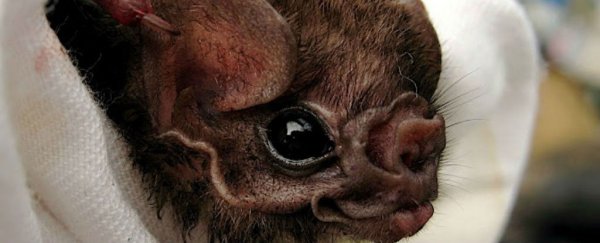As intimidating as they might sound, vampire bats aren't usually in the business of bothering humans for their blood. In fact, the hairy-legged vampire bat species was thought to feed almost exclusively on birds.
But researchers have discovered that hairy-legged vampire bats in north-east Brazil have managed to kick things up a notch - they've been caught feeding on humans by night, and that's something no one even thought was possible.
"We were quite surprised," Enrico Bernard from the Federal University of Pernambuco in Brazil told New Scientist.
"This species isn't adapted to feed on the blood of mammals."
Before scientists made this rather disturbing discovery, if you had to pick a species of vampire bat to be most worried about, the common vampire bat (Desmodus rotundus) would have been the obvious choice.
There are three existing species of vampire bat, all native to the Americas, and the common vampire bat is the only one that prefers the blood of mammals.
Domesticated animals, such as cows, horses, and pigs, are the preferred hosts of these nocturnal parasites, but despite having a taste for mammal blood, the common vampire bat very rarely targets humans.
And then there's the white-winged vampire bat (Diaemus youngi) and the hairy-legged vampire bat (Diphylla ecaudata), which were thought to feed primarily on birds, such as domestic chickens.
What should theoretically keep humans safe from these bird-targeting bats is the fact that feeding on blood is an extremely difficult adaptation for a mammal to achieve.
Extreme morphological, physiological, and behavioural adaptations are required for a species to evolve as blood-feeders, and suddenly switching from avian to mammal blood? That didn't even seem possible.
As Bernard and his team report:
"Mammal and bird blood differ in their composition, mainly in terms of nutrient composition. Bird blood, for example, has higher amount of water and fat, whereas mammal blood is rich in dry matter, mainly proteins.
Studies on the feeding physiology of the common vampire bat D. rotundus showed that this species has physiological characteristics that allow higher efficiency in protein processing.
On the other hand, species with a preference for bird blood, such as D. youngi and D. ecaudata, have higher ability to process and use large amounts of fat found in the blood of their prey."
And it's not just the theoretical challenges that appear to be involved in switching between a diet of avian blood and a diet of mammal blood.
As Sandrine Ceurstemont reports for New Scientist, previous experiments have shown that when only pig and goat blood was made available to bats that were used to bird blood, many of them opted to fast rather than diversify their diet - and sometimes even starved to death.
But when Bernard and his team investigated the diets of a colony of hairy-legged vampire bats in the Caatinga dry forests of northeastern Brazil, they found something strange.
Genetic analysis of 15 faecal samples contained bird DNA as expected, but 3 of those samples contained a mixture of human and bird DNA - evidence that these particular individuals had been feeding on both.
Interestingly, the team notes that these bats' most common grey - the white-browed guan, the yellow-legged tinamou, and the picazuro pigeon - have been disappearing in the area due to deforestation and hunting.
Domesticated birds such as chickens presented an even more tempting option in the face of large wild birds declining, and because many of the locals keep their chickens in close contact, the desperate bats developed a taste for both.
"House conditions in Catimbau are usually poor, and domestic animals are usually in close contact with humans, what may explain the occurrence of both chicken and human blood in our samples," the team reports.
There are a lot of open questions here - the biggest one being exactly how this colony of bats is able to process the protein-heavy blood of humans, when they've evolved to digest the fat-rich blood of birds instead.
The other question is if this could pose a serious risk to their new human hosts.
As Daniel Becker from the University of Georgia, who wasn't involved in the study, told New Scientist, the species has been found to carry the hantavirus in the past - and this can be fatal to humans who are infected by it.
The research has been published in Acta Chiropterologica.
